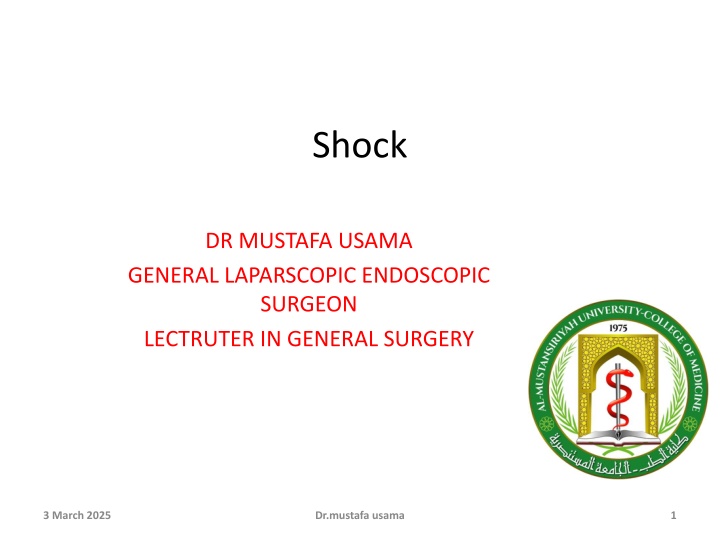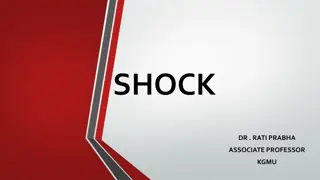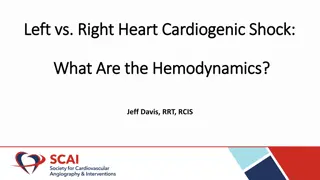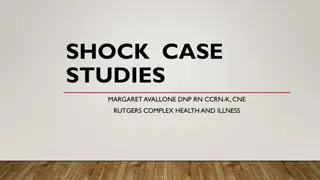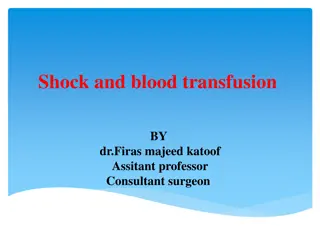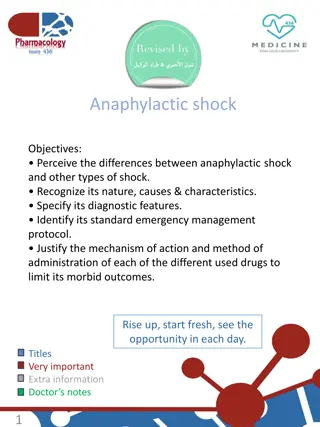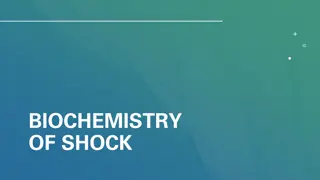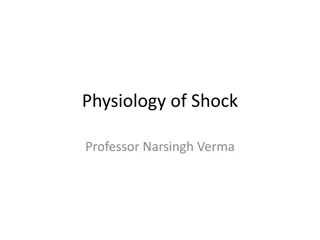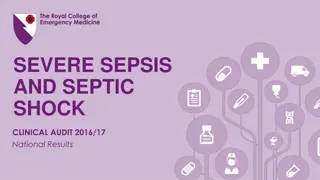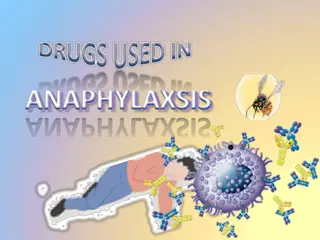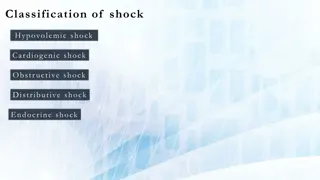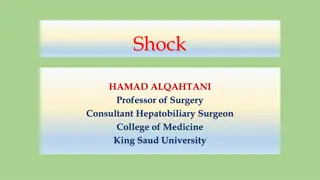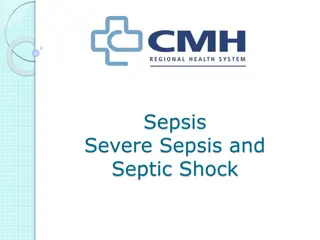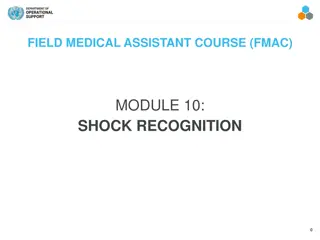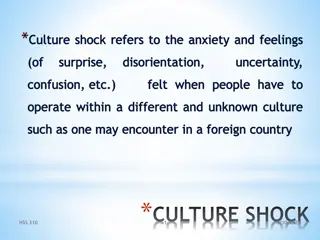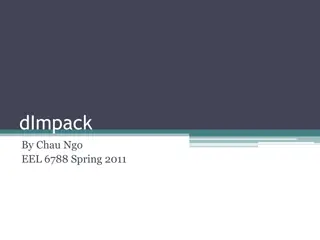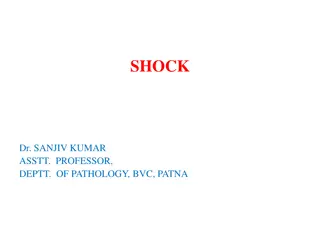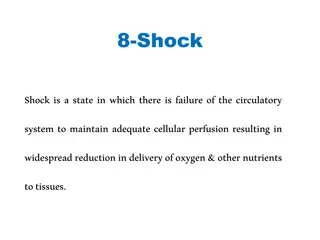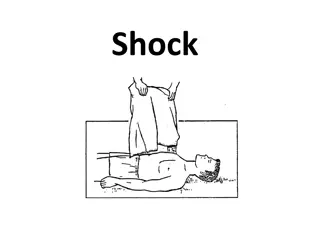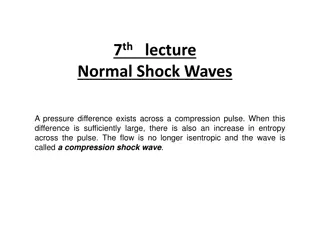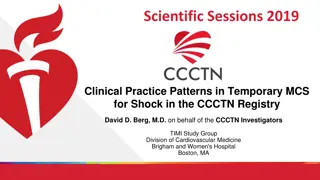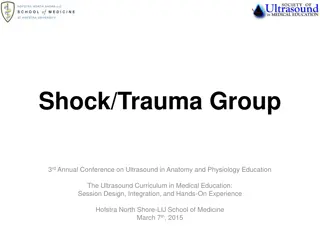Shock
A comprehensive overview of shock, covering its pathophysiology, types, resuscitation strategies, blood component usage, and irreversible phases. Learn about the impact of shock at the cellular level and the progression through compensatory and irreversible stages.
Download Presentation

Please find below an Image/Link to download the presentation.
The content on the website is provided AS IS for your information and personal use only. It may not be sold, licensed, or shared on other websites without obtaining consent from the author.If you encounter any issues during the download, it is possible that the publisher has removed the file from their server.
You are allowed to download the files provided on this website for personal or commercial use, subject to the condition that they are used lawfully. All files are the property of their respective owners.
The content on the website is provided AS IS for your information and personal use only. It may not be sold, licensed, or shared on other websites without obtaining consent from the author.
E N D
Presentation Transcript
Shock DR MUSTAFA USAMA GENERAL LAPARSCOPIC ENDOSCOPIC SURGEON LECTRUTER IN GENERAL SURGERY 3 March 2025 Dr.mustafa usama 1
Learning objects 1 1- -to understand pathophysiology of shock and to understand pathophysiology of shock and ischemic reperfusion injury . ischemic reperfusion injury . 2 2- -to understand different types of shocks and its to understand different types of shocks and its resuscitations. resuscitations. 3 3- - who to monitors and end point of resuscitations ? who to monitors and end point of resuscitations ? 4 4- - to learn who to use the blood and its component to learn who to use the blood and its component ,advantages and disadvantages of blood transfusions . ,advantages and disadvantages of blood transfusions . 3 March 2025 Dr.mustafa usama 2
3 March 2025 Dr.mustafa usama 3
Shock is systemic low tissue perfusion is systemic low tissue perfusion which is inadequate for normal cellular respiration. With insufficient delivery of oxygen and glucose, cells switch from aerobic to anaerobic metabolism. If perfusion is not restored in a timely fashion, cell death ensues. (failure to meet the metabolic need of cell that the consequences will ensue ). The initial injury is reversible but if prolong Duration will be irreversible Duration will be irreversible. 3 March 2025 Dr.mustafa usama 4
Pathophysiology of shock Cellular: Cellular: A reduced tissue perfusion at cellular level ,mean low O2 tension the cell change to anaerobic metabolism ,the end products is not carbon dioxide , lactic acidosis. Glucose metabolism is diminished and anaerobic is abolished the sodium/potassium pump intracellular is stooped ,intracellular lysosomes release and potassium release 3 March 2025 Dr.mustafa usama 5
3 March 2025 Dr.mustafa usama 6
Phases of shock In hemorrhagic shock, the body can compensate for the initial loss of blood volume primarily through the neuroendocrine response to maintain hemodynamics. This represents the compensated phase of shock. With continued hypoperfusion, which may be unrecognized, cellular death and injury are ongoing and the decompensation phase of shock ensues. Ischemia/reperfusion injury will often exacerbate the initial insult. 3 March 2025 Dr.mustafa usama 7
These effects at the cellular level, if untreated, will lead to compromise of function at the organ system level, thus leading to the vicious cycle of shock . Persistent hypoperfusion results in further hemodynamic derangements and cardiovascular collapse. This has been termed the irreversible phase of shock and can develop quite insidiously and may only be obvious in retrospect. 3 March 2025 Dr.mustafa usama 8
3 March 2025 Dr.mustafa usama 9
3 March 2025 Dr.mustafa usama 10
Micro vascular Micro vascular :injury to the capillary endothelium by :injury to the capillary endothelium by activation immune and coagulation system leading leaky activation immune and coagulation system leading leaky fluid and fluid and t tissue edema and cellular hypoxia issue edema and cellular hypoxia Systemic: Systemic: Cardiovascular tachycardia and systemic Cardiovascular tachycardia and systemic vasoconstriction vasoconstriction Renal Renal Renin Renin angiotensin angiotensin aldosterone :sodium and water aldosterone :sodium and water reabsorbtion reabsorbtion , , 3 March 2025 Dr.mustafa usama 11
Respiratory Respiratory : metabolic acidosis ,compensatory : metabolic acidosis ,compensatory respiratory alkalosis respiratory alkalosis Endocrine :activation renin angiotensin aldosterone, Endocrine :activation renin angiotensin aldosterone, Release cortisol and Release cortisol and catecholomine catecholomine 3 March 2025 Dr.mustafa usama 12
3 March 2025 Dr.mustafa usama 13
3 March 2025 Dr.mustafa usama 14
3 March 2025 Dr.mustafa usama 15
Dx Dx :the clinical sign include :the clinical sign include agitation agitation, , cool ,clammy cool ,clammy extremities, tachycardia, weak extremities, tachycardia, weak or absent or absent peripheral pulses peripheral pulses, and hypotension. Treatment Treatment : : The The appropriate priorities in these patients are appropriate priorities in these patients are ( (a) a) Secure the Secure the airway, (b) control the source of blood airway, (b) control the source of blood loss, and (c) loss, and (c) intravenous (IV intravenous (IV) volume , and hypotension. ) volume resuscitation. resuscitation. 3 March 2025 Dr.mustafa usama 16
Types of shock Hypovolemic shock: Hypovolemic shock: Cardiogenic shock Cardiogenic shock Obstructive . Obstructive . Distributive shock :Septic shock ,anaphylaxis ,spinal Distributive shock :Septic shock ,anaphylaxis ,spinal cord injury cord injury . . Endocrine . Endocrine . Traumatic . Traumatic . 3 March 2025 Dr.mustafa usama 17
Hypovolemic shock: Hypovolemic shock: The most common shock May be hemorrhagic or non hemorrhagic . Non haemorrhgic include dehydration, fliud loss (vomiting and diarrhea ). vomiting and diarrhea ).urinary loss diabetes .evaporation.third third space gastrointestinal tract or interstial spaces(intestinal obstruction ,pancreatitis ). dehydration,excessive space ex :fluid loss in the 3 March 2025 Dr.mustafa usama 18
Cardiogenic Cardiogenic shock clinically defined as clinically defined as circulatory diminished forward flow and subsequent diminished forward flow and subsequent tissue hypoxia. Causes: Causes: 1 1- - myocardial infarction (most common ) myocardial infarction (most common ) 2 2- -pump failure pump failure Mechanical complication : Mechanical complication : ( (vulvular vulvular heart disease . Pericardial heart disease . Pericardial temponade 3 3- -cardiac cardiac arrythmyia arrythmyia . . 4 4- -sever myocardial (blunt, penetrating) injury . sever myocardial (blunt, penetrating) injury . 5 5- -cardiomyopathy . cardiomyopathy . 6 6- -left ventricle outflow obstruction: aortic stenosis or failure of left ventricle outflow obstruction: aortic stenosis or failure of left ventricle filling (mitral stenosis).also mitral regurgitation or left ventricle filling (mitral stenosis).also mitral regurgitation or aortic aortic insuffenciey insuffenciey shock : : circulatory pump failure pump failure leading to leading to tissue hypoxia. temponade ) ) 3 March 2025 Dr.mustafa usama 19
7 7- -Metabolic :(sepsis ) Metabolic :(sepsis ) 8 8- - drug reaction . Dx :clinical sign : Dx :clinical sign : Circulatory shock Circulatory shock include hypotension, cool and mottled skin, include hypotension, cool and mottled skin, depressed mental depressed mental status, tachycardia, and diminished pulses. status, tachycardia, and diminished pulses. sustained hypotension (i.e., sustained hypotension (i.e., SBP< SBP<90 minutes), reduced cardiac index(< minutes), reduced cardiac index(<2.2 and elevated pulmonary and elevated pulmonary artery wedge artery wedge pressure (> Mortality Mortality rates for rates for cardiogenic shock cardiogenic shock are Confirmation of a cardiac source for the shock Confirmation of a cardiac source for the shock Requires electrocardiogram and urgent echocardiography Requires electrocardiogram and urgent echocardiography. . other chest other chest radiograph, arterial blood radiograph, arterial blood gases, electrolytes complete blood count, and cardiac enzymes. complete blood count, and cardiac enzymes. Invasive cardiac Invasive cardiac monitoring, which generally is not necessary, monitoring, which generally is not necessary, can be can be useful to exclude right ventricular infarction, useful to exclude right ventricular infarction, hypovolemia and and possible mechanical possible mechanical complications. complications. drug reaction . 90 mmHg for at least mmHg for at least 30 2.2 L/min per square meter), L/min per square meter), pressure (>15 are 50 50% to % to 80 30 15 mmHg mmHg). ). 80% % gases, electrolytes, , hypovolemia, , 3 March 2025 Dr.mustafa usama 20
Treatment : Treatment : Intubation Intubation and mechanical and mechanical ventilation. delivery delivery judicious judicious fluid administration fluid administration to to avoid fluid overload and avoid fluid overload and development of cardiogenic pulmonary edema development of cardiogenic pulmonary edema. . Dopamine Dopamine stimulates stimulates receptors (vasoconstriction), receptors (vasoconstriction), 1 1 receptors ( stimulation stimulation), and ), and 2 2 receptors (vasodilation), with its effects receptors (vasodilation), with its effects on receptors predominating at lower doses. receptors predominating at lower doses. Dopamine Dopamine may may be preferable be preferable to to dobutamine dysfunction in dysfunction in hypotensive patients hypotensive patients. . Intra Intra- -aortic aortic balloon pumping balloon pumping Increases cardiac Increases cardiac output and improves coronary blood flow by output and improves coronary blood flow by reduction reduction of systolic of systolic afterload and augmentation of diastolic afterload and augmentation of diastolic perfusion pressure perfusion pressure. . ventilation. adequate adequate myocardial O myocardial O2 2 receptors (cardiac cardiac on dobutamine in treatment of cardiac in treatment of cardiac 3 March 2025 Dr.mustafa usama 21
Obstructive shock is a reduction in preload due is a reduction in preload due to mechanical cardiac filling cardiac filling. . Common Common causes causes of obstructive of obstructive shock include cardiac cardiac tamponade tamponade, , tension pneumothorax. tension pneumothorax. massive pulmonary embolus or air massive pulmonary embolus or air embolus IVC IVC obstruction obstruction: Deep : Deep venous venous thrombosis Gravid IVC Neoplasm IVC Neoplasm Increased Increased intrathoracic intrathoracic pressure pressure Excess expiratory expiratory pressure.Neoplasm pressure.Neoplasm. . In In each each case, there case, there is reduced filling of the left is reduced filling of the left and or right sides of the sides of the heart leading heart leading to reduced preload and a fall in to reduced preload and a fall in cardiac cardiac output. output. to mechanical obstruction of obstruction of shock include embolus. . thrombosis Gravid uterus on uterus on Excess positive end positive end- - and or right 3 March 2025 Dr.mustafa usama 22
Dx and treatment to underlying cause . Dx and treatment to underlying cause . Distributive shock : Distributive shock :Neurogenic .septic ,anaphylactic Neurogenic .septic ,anaphylactic Neurogenic shock : Neurogenic shock : refers to diminished tissue refers to diminished tissue perfusion vasomotor tone to peripheral arterial beds. vasomotor tone to peripheral arterial beds. Loss of vasoconstrictor impulses results in increased Loss of vasoconstrictor impulses results in increased vascular capacitance vascular capacitance, decreased venous return, and , decreased venous return, and decreased decreased cardiac output. cardiac output. Causes of neurogenic shock Causes of neurogenic shock Spinal cord trauma Spinal cord trauma Spinal cord neoplasm Spinal cord neoplasm Spinal/epidural Spinal/epidural anesthetic. anesthetic. perfusion as a as a result of loss of result of loss of 3 March 2025 Dr.mustafa usama 23
Diagnosis : Diagnosis : The classic The classic description of neurogenic shock consists description of neurogenic shock consists of of decreased blood decreased blood pressure associated with pressure associated with bradycardia bradycardia (absence of (absence of reflexive tachycardia reflexive tachycardia due to disrupted sympathetic discharge), disrupted sympathetic discharge), Warm extremities Warm extremities (loss of (loss of peripheral peripheral vasoconstriction). vasoconstriction). Motor Motor and and sensory deficits sensory deficits indicative of a spinal cord injury. injury. R Radiographic evidence adiographic evidence of a vertebral column fracture. of a vertebral column fracture. due to indicative of a spinal cord 3 March 2025 Dr.mustafa usama 24
Treatment :ICU Treatment :ICU After the airway is secured and ventilation is After the airway is secured and ventilation is adequate, fluid adequate, fluid resuscitation and restoration of resuscitation and restoration of intravascular intravascular volume often volume often will improve perfusion in neurogenic neurogenic shock. shock. If the hypotension not restored .@ &B receptors If the hypotension not restored .@ &B receptors dopamine or dopamine or phenylepinephrine phenylepinephrine .the vasoconstrictors for for 24 24- -48 48 hours . hours . will improve perfusion in .the vasoconstrictors 3 March 2025 Dr.mustafa usama 25
Septic shock and Septic shock and vasodilatory Vasodilatory Vasodilatory shock is the result of dysfunction of the shock is the result of dysfunction of the endothelium and vasculature secondary to circulating endothelium and vasculature secondary to circulating inflammatory mediators inflammatory mediators and cells or as a response to and cells or as a response to prolonged prolonged and severe and severe hypoperfusion hypoperfusion. . Thus Thus, in , in vasodilatory vasodilatory shock, shock, hypotension results failure of the vascular smooth muscle to constrict failure of the vascular smooth muscle to constrict appropriately. appropriately. Vasodilatory Vasodilatory shock is characterized by peripheral shock is characterized by peripheral vasodilation with resultant hypotension and resistance vasodilation with resultant hypotension and resistance to to treatment with vasopressors. treatment with vasopressors. vasodilatory shock : shock : hypotension results from from 3 March 2025 Dr.mustafa usama 26
Causes : Causes : Systemic response to infection Systemic response to infection Noninfectious systemic inflammation Noninfectious systemic inflammation (Pancreatitis ,Burns) (Pancreatitis ,Burns) Anaphylaxis Anaphylaxis Acute adrenal insufficiency Acute adrenal insufficiency Prolonged, severe hypotension Prolonged, severe hypotension (Hemorrhagic shock ,Cardiogenic shock, (Hemorrhagic shock ,Cardiogenic shock, Cardiopulmonary bypass) Cardiopulmonary bypass) Metabolic (Hypoxic Metabolic (Hypoxic lactic lactic acidosi,Carbon poisoning). poisoning). acidosi,Carbon monoxide monoxide 3 March 2025 Dr.mustafa usama 27
Dx Dx: : Patients Patients with sepsis have evidence of with sepsis have evidence of an infection as systemic signs of inflammation (e.g., as systemic signs of inflammation (e.g., fever, leukocytosis and tachycardia). and tachycardia). Hypoperfusion Hypoperfusion with signs dysfunction is termed dysfunction is termed severe sepsis . severe sepsis . Blood culture before antibiotic administration. Blood culture before antibiotic administration. Serum lactate level. Serum lactate level. Treatment : Treatment : mechinical mechinical ventilation . ventilation . Steriod Steriod , ,vassopressors vassopressors (phenyl (phenyl ipinephrine Dobutamine Dobutamine . . iv broad iv broad spectum spectum antioboitics antioboitics . . restoration of fluid crystalloid volume restoration of fluid crystalloid volume 30 Iv insulin for hyperglycemia. Iv insulin for hyperglycemia. an infection, as well fever, leukocytosis, , with signs of organ of organ , as well ipinephrine ) ) 30ml/kg . ml/kg . 3 March 2025 Dr.mustafa usama 28
Anaphylactic shock Anaphylactic shock : massive release of histamine for any allergy . : massive release of histamine for any allergy . Endocrine shock Endocrine shock : : hypo or hyper hypo or hyper thyroidism thyroidism ,adrenal insufficiency. ,adrenal insufficiency. Hypothytroidism Hypothytroidism similar to neurogenic shock in decreasing cardiac similar to neurogenic shock in decreasing cardiac and vascular response to circulating catecholamine ,decreasing the and vascular response to circulating catecholamine ,decreasing the cardiac output . cardiac output . Hyperthyoidism Hyperthyoidism causing high output cardiac failure . causing high output cardiac failure . Adrenal insufficiency: Adrenal insufficiency: shock due to shock due to hypovolaemia a poor response to circulating and exogenous a poor response to circulating and exogenous catecholamines Adrenal insufficiency may be due to pre Adrenal insufficiency may be due to pre- -existing Addison or be a relative insufficiency due to a pathological disease or be a relative insufficiency due to a pathological disease state, such as systemic sepsis. state, such as systemic sepsis. hypovolaemia and and catecholamines. . existing Addison s disease s disease 3 March 2025 Dr.mustafa usama 29
Severity of shock 3 March 2025 Dr.mustafa usama 30
Consequences of shock Unresuscitatable Unresuscitatable shock Patients who are in profound shock for a prolonged period of Patients who are in profound shock for a prolonged period of time become time become unresuscitatable unresuscitatable . . Cell Cell death follows from death follows from cellular cellular ischaemia compensate is lost. compensate is lost. There is myocardial depression and loss of responsiveness to fluid There is myocardial depression and loss of responsiveness to fluid or inotropic therapy. or inotropic therapy. Peripherally Peripherally there is loss of the ability there is loss of the ability to maintain resistance and further resistance and further hypotension ensues hypotension ensues. . The peripheries no longer respond appropriately to vasopressor The peripheries no longer respond appropriately to vasopressor agents. Death is the inevitable agents. Death is the inevitable Multiple organ failure : Multiple organ failure : Effects of organ failure Effects of organ failure Lung: Acute respiratory distress syndrome Kidney: Acute liver insufficiency Clotting: Coagulopathy Cardiac: Cardiovascular failure shock ischaemia and the ability of the body to and the ability of the body to to maintain systemic vascular systemic vascular 3 March 2025 Dr.mustafa usama 31
Resuscitation and monitoring Monitoring : Monitoring : Minimum ECG Pulse oximetry Blood pressure Urine output Additional modalities Central venous pressure Invasive blood pressure Cardiac output Base deficit and serum lactate . 3 March 2025 Dr.mustafa usama 32
Fluid therapy Fluid therapy The best fluid between colloid and crystalloid . The best fluid between colloid and crystalloid . ( Ringer / ( Ringer /hartman hartman solution ,ringer lactate ,normal solution ,ringer lactate ,normal saline ). saline ). The blood . The blood . Base deficient / serum lactate level > Base deficient / serum lactate level >6 6mmol/l Sever metabolic acidosis . Sever metabolic acidosis . mmol/l 3 March 2025 Dr.mustafa usama 33
3 March 2025 Dr.mustafa usama 34
3 March 2025 Dr.mustafa usama 35
3 March 2025 Dr.mustafa usama 36
3 March 2025 Dr.mustafa usama 37
3 March 2025 Dr.mustafa usama 38
3 March 2025 Dr.mustafa usama 39
3 March 2025 Dr.mustafa usama 40
